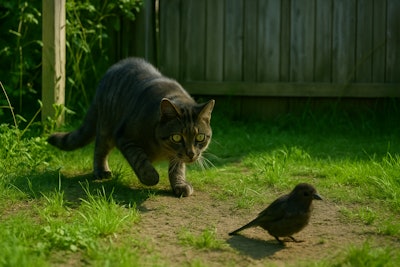
Pets create conservation contradictions. Dog, cat and other pet owners’ relationships with their own animals may encourage empathy for other animals, including pets’ wild relatives like wolves and jaguars. Nevertheless, some pet-keeping practices can harm wildlife.
“While there is some overlap between the goals of animal welfare advocates and wildlife conservationists, priorities remain misaligned, especially where companion and wild animals interact,” Miguel Gomez-Serrano, ecology lecturer at the University of Valencia, wrote in the journal Biological Conservation. “These differences in priorities and frameworks can create significant challenges when addressing conservation strategies that involve the interaction of pets and wild animals.”
Adapting policy suggestions to pet food
Gomez-Serrano’s paper was a policy analysis. It focused mainly on legislative and policy aspects of the misalignment between pet ownership and wildlife conservation in the European Union. However, many of his observations could be adapted to pet food company’s sustainability initiatives.
Pet food companies, positioned at the intersection of animal care and environmental responsibility, have an opportunity to educate and influence consumers. Based on the report's findings, here are five practical actions pet food companies can encourage pet owners to take to reduce their pets’ impacts on wildlife.
1. Prevent pets from becoming feral
Pet abandonment can result in the formation of feral populations, which pose serious threats to native species. The establishment of self-sustaining populations of feral pets illustrates this risk, including cats, dogs, reptiles and birds, such as Ring-necked Parakeets in the EU or Burmese Python in the US. Pet food companies can support responsible ownership campaigns, including messaging on product packaging and digital platforms, urging pet owners to avoid releasing pets into the wild and to utilize proper rehoming services if they can no longer care for an animal.
2. Keep cats indoors or under control
Domestic cats are a leading cause of wild animal mortality worldwide, and are partly responsible for numerous extinctions of birds, mammals and reptiles. The study stressed that allowing cats to roam freely contributes significantly to biodiversity loss, particularly near sensitive habitats and breeding areas. Pet food brands can promote indoor enrichment strategies or secure outdoor enclosures (known as “catios”) as alternatives that meet pets’ behavioral needs while minimizing their environmental impact.
3. Leash dogs during nature walks
While dog walking is a common and healthy activity, dogs off-leash in natural areas can disturb nesting birds and other wildlife. For example, shorebirds like the Kentish plover are highly vulnerable to disturbance from roaming dogs. The study notes that non-compliance with leash regulations is widespread. Pet food companies can advocate for leashing as a form of environmental stewardship, potentially partnering with local authorities or NGOs to raise awareness about the importance of leashing dogs in sensitive ecosystems.
4. Support spay/neuter initiatives
Free-roaming pet populations, particularly cats, can maintain high densities around human settlements, perpetuating the cycle of wildlife predation exacerbated by habitat loss. While trap-neuter-return programs are popular, they are not always effective in reducing populations in the short term. The research suggests high-intensity sterilization programs and adoption over return as more effective alternatives. Pet food companies can help by supporting community spay/neuter drives or including educational inserts with product shipments.
5. Avoid encouraging pet ownership of invasive species
Certain exotic species, such as previously mentioned Parakeets and Pythons, are charismatic and popular in the pet trade but have established invasive populations due to escapes and releases. These species can outcompete native birds and spread diseases. Pet food manufacturers and retailers serving nontraditional pet markets could educate pet owners about non-native species that pose known ecological risks. Product labeling and marketing materials could include information about the environmental implications of keeping certain species.
The report urges a coordinated policy response to address the misalignment between animal welfare and wildlife conservation, but until legislation catches up, industry-led education can fill part of that gap. Pet food companies are uniquely positioned to influence owner behavior by promoting responsible practices that protect both pets and the ecosystems they depend upon.

















